

Island (Huxley novel) Island is the final book by English writer Aldous Huxley, published in 1962.
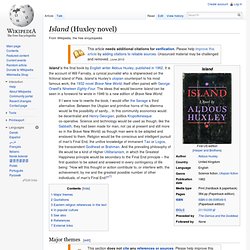
It is the account of Will Farnaby, a cynical journalist who is shipwrecked on the fictional island of Pala. Island is Huxley's utopian counterpart to his most famous work, the 1932 novel Brave New World, itself often paired with George Orwell's Nineteen Eighty-Four. Animal Farm. Animal Farm is an allegorical and dystopian novel by George Orwell, published in England on 17 August 1945.
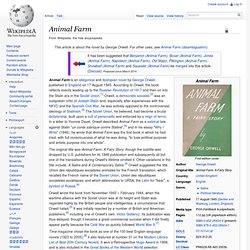
According to Orwell, the book reflects events leading up to the Russian Revolution of 1917 and then on into the Stalin era in the Soviet Union.[1] Orwell, a democratic socialist,[2] was an outspoken critic of Joseph Stalin and, especially after experiences with the NKVD and the Spanish Civil War, he was actively opposed to the controversial ideology of Stalinism.[3] The Soviet Union, he believed, had become a brutal dictatorship, built upon a cult of personality and enforced by a reign of terror.
In a letter to Yvonne Davet, Orwell described Animal Farm as a satirical tale against Stalin "un conte satirique contre Staline", and in his essay "Why I Write" (1946), he wrote that Animal Farm was the first book in which he had tried, with full consciousness of what he was doing, "to fuse political purpose and artistic purpose into one whole". Plot summary Characters Pigs Humans Origin. Brave New World.
Classic 1932 science fiction novel by Aldous Huxley In 1999, the Modern Library ranked Brave New World as #5 on its list of the 100 best English-language novels of the 20th century.[2] In 2003, Robert McCrum, writing for The Observer, included Brave New World chronologically at #53 in "the top 100 greatest novels of all time",[3] and the novel was listed at #87 on The Big Read survey by the BBC.[4] Title[edit] O wonder!
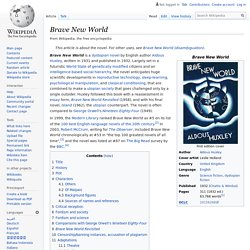
How many goodly creatures are there here! How beauteous mankind is! Moon of Mutiny. Moon of Mutiny is a juvenile Science fiction novel by author Lester del Rey published in 1961 by Holt, Rinehart & Winston as the final part of the Jim Stanley Series (the first two books being Step to the Stars and Mission to the Moon).

The story takes place mostly on the Moon following the adventures of the main character Fred Halpern after he is expelled from Goddard Space Academy for insubordination, and tries to find his way back into space. It was probably most popular as a part of the Winston Juvenile Science Fiction set which included 36 books by such authors as Arthur C.
Clarke, Ben Bova, Poul Andersen, including 5 by del Rey. The dust jacket features an illustration by 5-time Hugo award winner Ed Emshwiller. Attack from Atlantis. Rendezvous with Rama. Rendezvous with Rama is a hard science fiction novel by Arthur C.
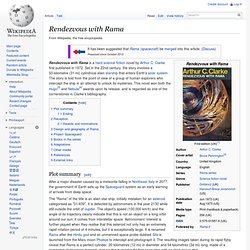
Clarke first published in 1972. Set in the 22nd century, the story involves a 50-kilometre (31 mi) cylindrical alien starship that enters Earth's solar system. The story is told from the point of view of a group of human explorers who intercept the ship in an attempt to unlock its mysteries. This novel won both the Hugo[3] and Nebula[4] awards upon its release, and is regarded as one of the cornerstones in Clarke's bibliography. Plot summary[edit] I, Robot. I, Robot is a collection of nine science fiction short stories by Isaac Asimov, first published by Gnome Press in 1950 in an edition of 5,000 copies.
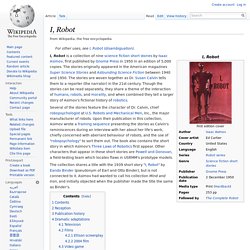
The stories originally appeared in the American magazines Super Science Stories and Astounding Science Fiction between 1940 and 1950. The stories are woven together as Dr. Susan Calvin tells them to a reporter (the narrator) in the 21st century. Though the stories can be read separately, they share a theme of the interaction of humans, robots, and morality, and when combined they tell a larger story of Asimov's fictional history of robotics. Nightfall (Asimov short story and novel) "Nightfall" is a 1941 science fiction short story by Isaac Asimov about the coming of darkness to the people of a planet ordinarily illuminated at all times on all sides.
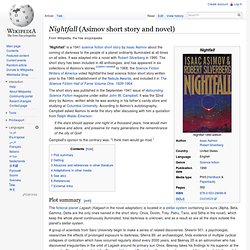
It was adapted into a novel with Robert Silverberg in 1990. The short story has been included in 48 anthologies, and has appeared in six collections of Asimov's stories. The Rolling Stones (novel) The Rolling Stones (also published under the name Space Family Stone in the United Kingdom) is a 1952 science fiction novel by Robert A.
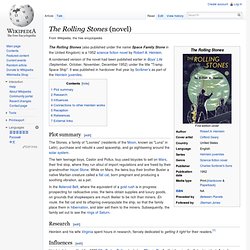
Heinlein. A condensed version of the novel had been published earlier in Boys' Life (September, October, November, December 1952) under the title "Tramp Space Ship". It was published in hardcover that year by Scribner's as part of the Heinlein juveniles. The Stones, a family of "Loonies" (residents of the Moon, known as "Luna" in Latin), purchase and rebuild a used spaceship, and go sightseeing around the solar system. In the Asteroid Belt, where the equivalent of a gold rush is in progress prospecting for radioactive ores, the twins obtain supplies and luxury goods, on grounds that shopkeepers are much likelier to be rich than miners.
Heinlein and his wife Virginia spent hours in research, fiercely dedicated to getting it right for their readers.[1] Jump up ^ Essay by Gregory Benford, 2011Jump up ^ Houdek, D. The Moon Is a Harsh Mistress. The Moon Is a Harsh Mistress is a 1966 science fiction novel by American writer Robert A.

Heinlein, about a lunar colony's revolt against rule from Earth. Widely admired for its credible presentation of a comprehensively imagined future human society on both the Earth and the moon, it is generally considered one of Heinlein's major novels as well as one of the most important science fiction novels ever written.[1] Originally serialized in Worlds of If (December 1965, January, February, March, April 1966), the book received the Hugo Award for best science fiction novel in 1967,[2] and was nominated for the Nebula Award in 1966.[3] Plot[edit] In 2075, underground colonies are scattered across the Moon (Luna), of which most inhabitants (called "Loonies") are criminals, political exiles, or descendants thereof.
The story is narrated by Manuel Garcia "Mannie" O'Kelly-Davis, a computer technician who discovers that HOLMES IV has achieved self-awareness and has developed a sense of humor. Operating Manual for Spaceship Earth. Operating Manual For Spaceship Earth is a short book by R.
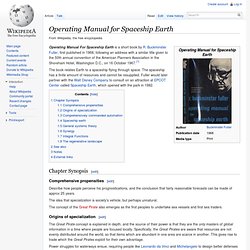
Buckminster Fuller, first published in 1968, following an address with a similar title given to the 50th annual convention of the American Planners Association in the Shoreham Hotel, Washington D.C., on 16 October 1967.[1] Chapter Synopsis[edit] Comprehensive propensities[edit] Describe how people perceive his prognostications, and the conclusion that fairly reasonable forecasts can be made of approx 25 years.
The idea that specialization is society's vehicle, but perhaps unnatural. The Illustrated Man. The Illustrated Man is a 1951 book of eighteen science fiction short stories by Ray Bradbury that explores the nature of mankind. A recurring theme throughout the eighteen stories is the conflict of the cold mechanics of technology and the psychology of people. It was nominated for the International Fantasy Award in 1952.[1] A number of the stories, including "The Veldt", "The Fox and the Forest" (as "To the Future"), "Marionettes, Inc.
", and "Zero Hour" were dramatized for the 1955-57 radio series X Minus One. Story summaries[edit] A mother and father in a futuristic society begin to worry about their children's mental health when the three-dimensional nursery they bought for them begins projecting a veldt in Africa populated by hungry lions feasting on a set of carcasses. The Shape of Things to Come. The Shape of Things to Come is a work of science fiction by H.
G. Wells, published in 1933, which speculates on future events from 1933 until the year 2106. In the book, a world state is established as the solution to humanity's problems. Plot[edit] As a frame story, Wells claims that the book is his edited version of notes written by an eminent diplomat, Dr Philip Raven, who had been having dream visions of a history textbook published in 2106 and wrote down what he could remember of it. Men Like Gods. Plot summary[edit] Men Like Gods is set in the summer of 1921. Its protagonist is Mr. Barnstaple (his first name is either Alfred or William[4]), a journalist working in London and living in Sydenham. He has grown dispirited at a newspaper called The Liberal and resolves to take a holiday. Quitting wife and family, he finds his plans disrupted when his and two other automobiles are accidentally transported with their passengers into "another world," which the "Earthlings" call Utopia.
A sort of advanced Earth, Utopia is some three thousand years ahead of humanity in its development. Mr. A Modern Utopia. Because of the complexity and sophistication of its narrative structure, H.G. Wells's A Modern Utopia (1905) has been called "not so much a modern as a postmodern utopia. Fahrenheit 451. Fahrenheit 451.